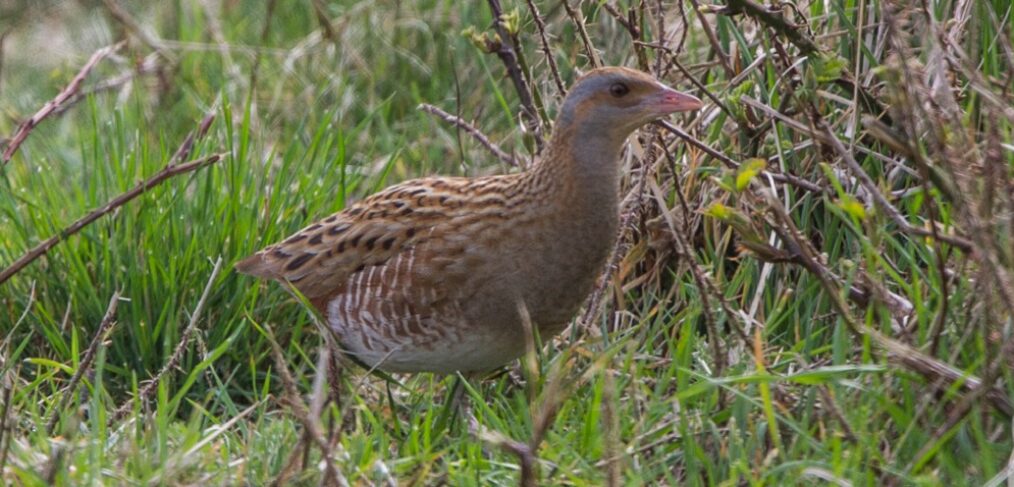
species of the week #65 – corncrake
A small head on a long neck towers above the stalks of a tall meadow and looks at you with lightning-quiet eyes? If you have ever been able to observe this, you are one of the lucky ones who have seen a corncrake in person. It is a master of camouflage and has become very rare. However, you hear it more often than you see it. Its characteristic song is not easily forgotten: it sounds like rubbing a spoon over the tines of a comb.
| Distribution status | Threatened with extinction, 20-30 territories in Rhineland-Palatinate |
| Remaining deposit | Westerwald, Anterior and Southern Palatinate |
| Last sighting in Rhineland-Palatinate | currently |
| Habitat | Open floodplains, sedge swamps, damp mountain meadows, also densely overgrown grassland as alternative habitats |
| Threat | Drainage of damp sites, ploughing up of grassland, intensive cultivation, shooting in hibernation areas |
It resembles a tender partridge, but is more uniformly coloured, longer-legged and thicker-billed. The chicks are quite dark and look like black cotton wools. The chicks are also the reason for a very special biotope selection. In the first days after hatching, the chicks are still very sensitive to wetness and die easily if they lie in high wet grass. Later, when they are already running around, they should not be seen by predators. To solve this dilemma, the corncrake watches very closely and chooses a site that is freshly mown or moderately overgrown when the nest is built. If by June/July – when the chicks are most active – the grass has grown taller or there is tall vegetation in the immediate vicinity, then the site is ideal.
Unfortunately, people often put a spoke in the corncrake’s wheel when mowing is done too early or there are no hiding places left within chick walking distance. Moreover, the corncrake is not very defensible shortly after breeding. This is because all its feathers fall out and it is unable to fly for three weeks. Towards the beginning of August, the young birds themselves are fully capable of flight, but by the end of July they can already flutter and escape the mowing tools by running. According to observations, even mown areas are bridged by running.
The corncrake actually prefers semi-open floodplains, sparsely vegetated sedimentation zones, sedge swamps and natural mountain meadows. In the meantime, however, it is mainly found in open, extensively used cultivated land with vegetation rich in cover of about 25 – 100 cm in height. In Central Europe, areas with winter and spring floods are used. The corncrake is a typical meadow bird species, but it also dwells in higher structures such as willow groves.
In spring, the males attract the night-migrating females to the breeding areas by forming “call carpets”. They like to sit higher up so that the females can hear them well. The more males call in suitable areas, the higher the probability that females will be attracted. If no females appear, the calls cease and the males disappear from the area.
In my home town of Gießen, corncrakes were observed again for the first time after the renaturation of the Wieseck floodplain and the return to traditional extensive floodplain management in the 1990s. Other endangered species such as kingfisher, lapwing and meadow pipit have also reestablished themselves here. This shows: protection and renaturation are effective!
Politically necessary:
- Conservation and rewetting of wetlands and moorland sites
- Promotion of small-parcel, coordinated mowing with remaining marginal strips
- Promote structurally rich, diverse agriculture with elevated, permanent calling sites e.g. trees.
Click here for more exciting species of the week
Photo: By Ron Knight from Seaford, East Sussex, United Kingdom – Corn Crake (Crex crex), CC BY 2.0, https://commons.wikimedia.org/w/index.php?curid=46950118
